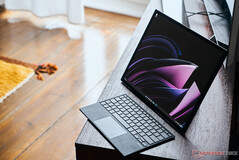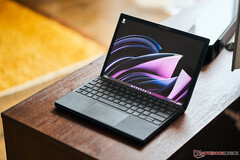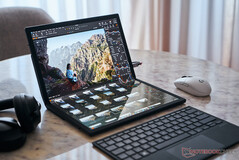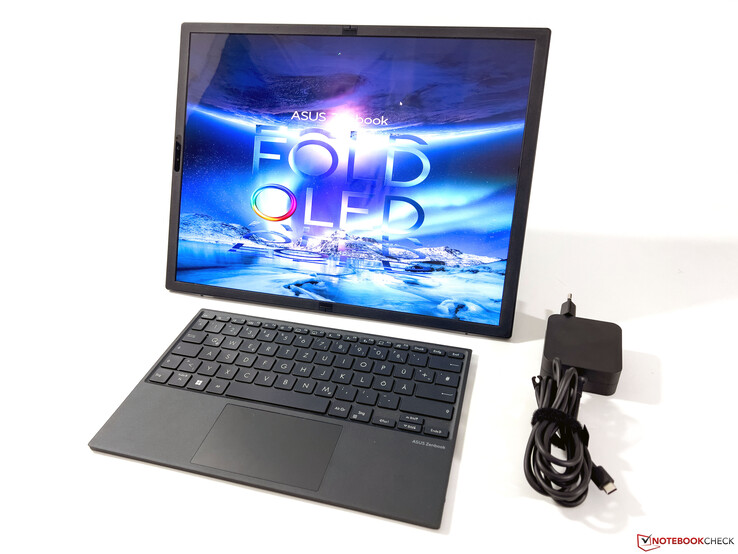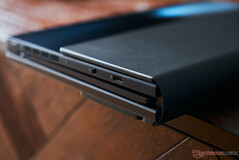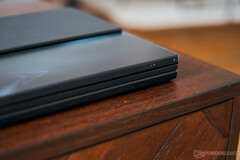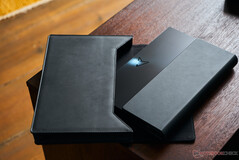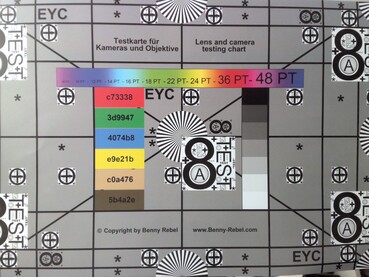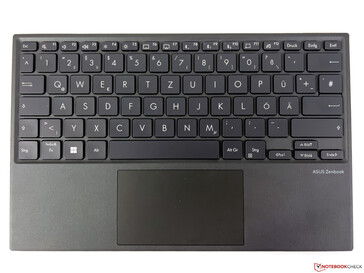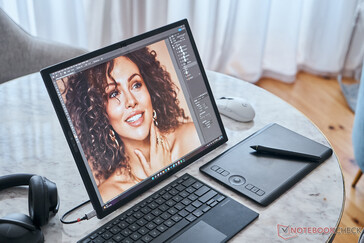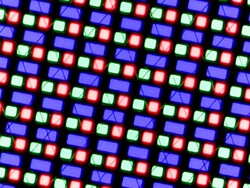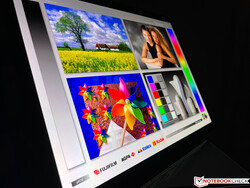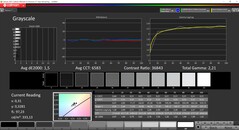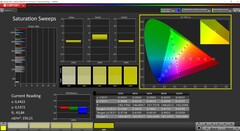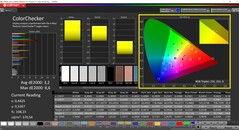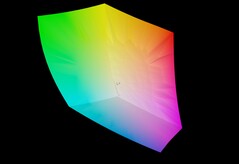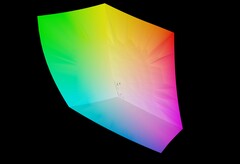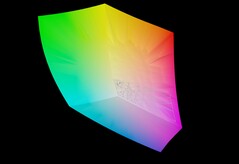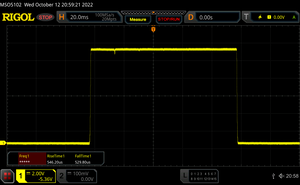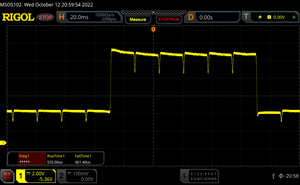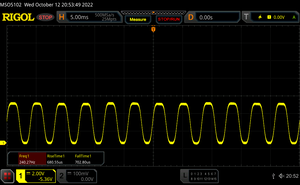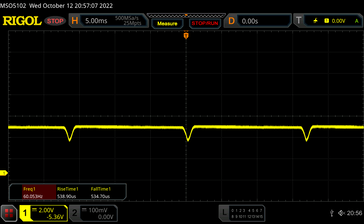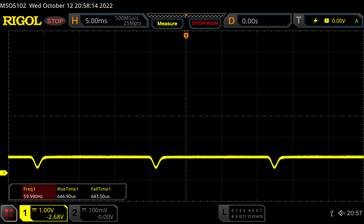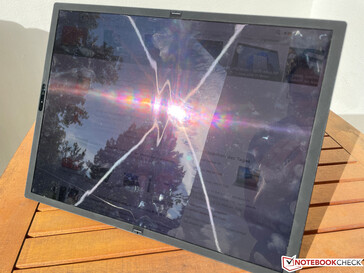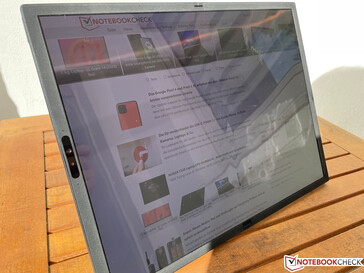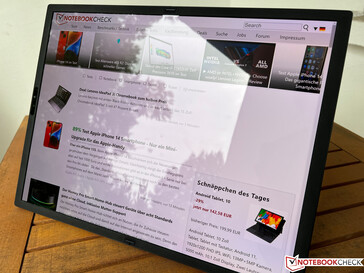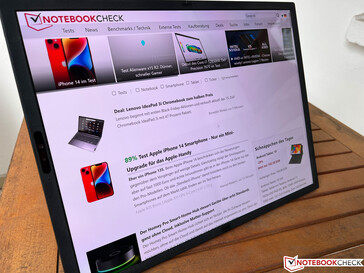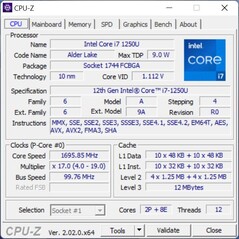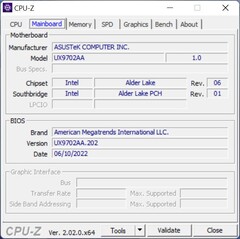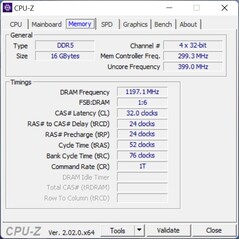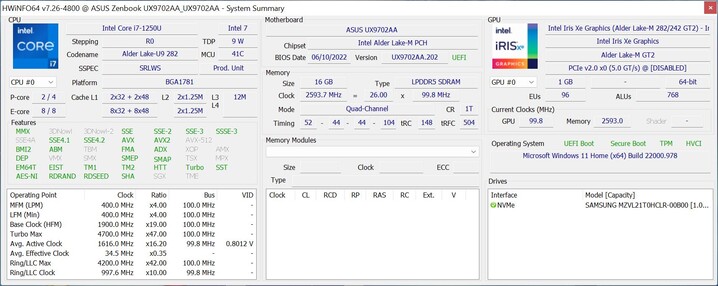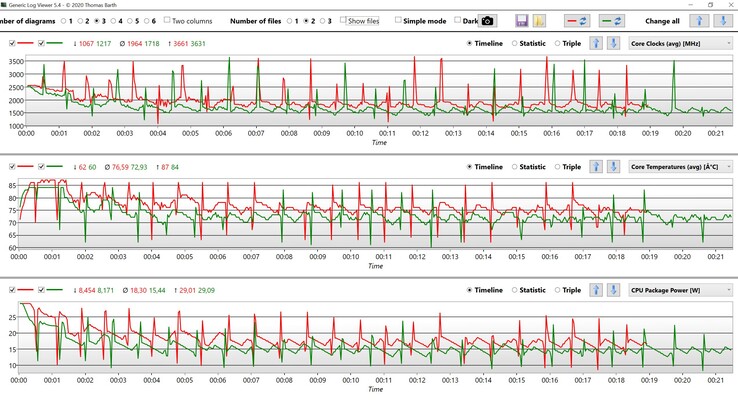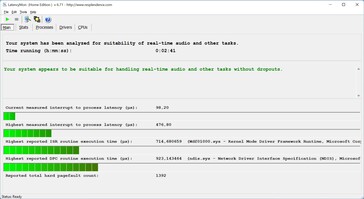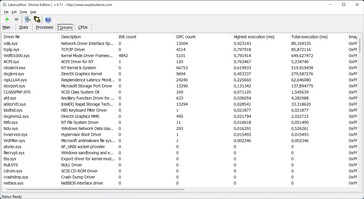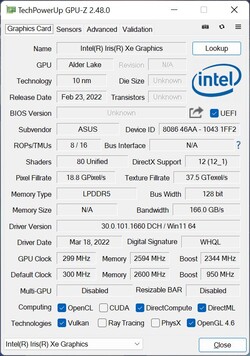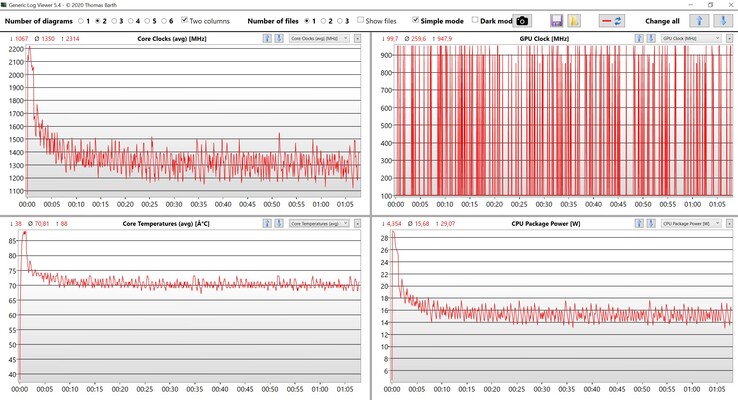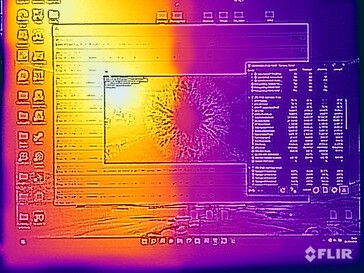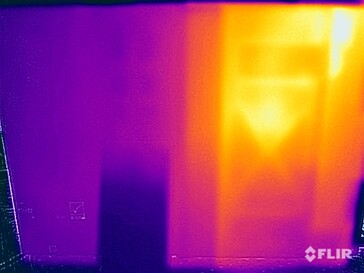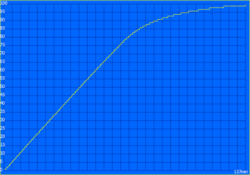Asus Zenbook 17 Fold w recenzji - debiutuje składany 17-calowy kabriolet z ekranem OLED

Choć składane wyświetlacze nie są już nowością w świecie smartfonów, to jednakThinkPad X1 Fold z dość małym 13,3-calowym ekranem, który nie oferuje zbyt wiele miejsca zwłaszcza w trybie laptopa, jest jedynym przedstawicielem w sektorze notebooków. Wraz z modelem Zenbook Fold, Asus stara się poprawić ten stan rzeczy, wypuszczając 17-calowy, składany kabriolet. Ekran OLED ma proporcje 4:3 i natywną rozdzielczość 2560 x 1920 pikseli. W systemie zastosowano Intel Core i7-1250U, niedawno wydany procesor Alder Lake-U o TDP wynoszącym zaledwie 9 W (do 29 W Turbo Boost).
Przy cenie detalicznej 3 499 USD Zenbook 17 Fold nie jest oczywiście do końca okazją. W tej recenzji sprawdzimy, jak dobrze ten duży, składany kabriolet nadaje się do codziennego użytku i czy rzeczywiście jest realnym mobilnym towarzyszem. Podczas gdy Zenbook 17 Fold nie ma obecnie bezpośrednich konkurentów, Lenovo ogłosiło nowy ThinkPad X1 Fold z 16-calowym wyświetlaczem OLED na tegorocznych targach IFA.
Potencjalni konkurenci w porównaniu
Ocena | Data | Model | Waga | Wysokość | Rozmiar | Rezolucja | Cena |
|---|---|---|---|---|---|---|---|
| 84.5 % v7 (old) | 10/2022 | Asus Zenbook 17 Fold UX9702 i7-1250U, Iris Xe G7 80EUs | 1.8 kg | 12.9 mm | 17.30" | 2560x1920 | |
| 88.7 % v7 (old) | Lenovo Yoga 7 16IAP7 i7-1260P, Iris Xe G7 96EUs | 2 kg | 19.2 mm | 16.00" | 2560x1600 | ||
| 85.8 % v7 (old) | 10/2024 | LG Gram 16 2-in-1 16T90P i7-1165G7, Iris Xe G7 96EUs | 1.5 kg | 17 mm | 16.00" | 2560x1600 | |
| 88.3 % v7 (old) | Microsoft Surface Book 3 15 i7-1065G7, GeForce GTX 1660 Ti Max-Q | 1.9 kg | 23 mm | 15.00" | 3240x2160 |
Obudowa - Zenbook Fold z metalową obudową
Po wstępnym rozpakowaniu Zenbook 17 Fold, użytkownicy zostaną przedstawieni z dużym 17-calowym tabletem, który czuje się znacznie bardziej masywny niż normalne tablety Android lub iOS. Urządzenie to w zasadzie cały ekran otoczony gumowaną ramką o szerokości około 6 mm (~0,24 cala). Metalowy charakter konstrukcji jest widoczny zarówno z tyłu, jak i na krawędziach, a z tyłu znajduje się dodatkowa osłona zawiasu, która zawiera wygodną podstawkę. Zenbook 17 Fold pozostawia ogólnie bardzo dobre wrażenie i nie zauważyliśmy żadnych wad w jakości wykonania. Niezależnie od tego gumowana ramka przyciąga kurz, a ekran dotykowy jest dość podatny na odciski palców, choć można je szybko usunąć.
Zenbook 17 Fold może być używany w różnych sytuacjach. Choć można go używać jak tabletu, najwygodniej jest ustawić go na biurku, by móc na nim normalnie pracować. Można wtedy ustawić przed nim dołączoną klawiaturę Bluetooth lub inne urządzenia wejściowe Bluetooth. Ponadto, możliwe jest korzystanie z kabrioletu w trybie portretowym poprzez wygięcie ekranu na środku. Wreszcie Fold może być oczywiście używany także w trybie laptopa. Gdy tylko (zablokowana magnetycznie) klawiatura Bluetooth zostanie umieszczona na dolnej połowie wyświetlacza, dolna część ekranu OLED zostaje wyłączona, aby uzyskać wrażenia zbliżone do tradycyjnego 12,5-calowego laptopa o rozdzielczości 1920 x 1280 pikseli i proporcjach 3:2. Zawias pozostawia solidne wrażenie i potwierdzono, że według Asusa wytrzyma 30000 cykli. Ponieważ obudowa nie jest przeznaczona do otwierania przez użytkowników, nie ma opcji konserwacji.
Z całkowitą wagą nieco powyżej 1,8 kg / ~3,97 lbs (1517 g tablet + 307 g klawiatura / ~3,34 lbs tablet + ~0,68 lbs klawiatura), Zenbook 17 Fold nie jest dokładnie lekki. Podobnie jego grubość wynosząca nieco ponad 3 cm (~1,18 cala) po złożeniu oznacza, że również nie jest zbyt kompaktowy. Tradycyjny 13-calowy laptop ma więc przewagę w kwestii przenośności. 65-watowa ładowarka waży dodatkowo 225 gramów (~0,50 lbs).
Łączność - Zenbook z Thunderbolt 4
Zenbook 17 Fold oferuje dwa porty USB typu-C z obsługą Thunderbolt 4, a także 3,5 mm jack audio. Porty zostały rozmieszczone z myślą o odpowiednich przypadkach użycia. Gdy używamy Folda jako tabletu, jeden z portów znajduje się na dole po lewej stronie, dzięki czemu nadaje się do ładowania. Drugi port USB znajduje się na górze. O ile jest to jeszcze akceptowalne dla thumbdrives USB, o tyle nie do końca jest to praktyczne dla dysków zewnętrznych. W trybie laptopa port ten znajduje się na środku, po prawej stronie.
Komunikacja
Asus wykorzystuje nowoczesny moduł Wi-Fi Intel AX211, który obsługuje już najnowszy standard Wi-Fi 6E. Podczas naszych testów bez problemu udało nam się połączyć z siecią 6-GHz naszego referencyjnego routera Asusa, a prędkości transferu są bardzo wysokie. Nie ma tu jednak modemu LTE ani 5G.
| Networking | |
| iperf3 receive AXE11000 6GHz | |
| Asus Zenbook 17 Fold UX9702 | |
| Przeciętny Intel Wi-Fi 6E AX211 (700 - 1857, n=224) | |
| Średnia w klasie Convertible (824 - 1763, n=37, ostatnie 2 lata) | |
| Lenovo Yoga 7 16IAP7 | |
| iperf3 transmit AXE11000 6GHz | |
| Asus Zenbook 17 Fold UX9702 | |
| Przeciętny Intel Wi-Fi 6E AX211 (385 - 1851, n=224) | |
| Średnia w klasie Convertible (685 - 1664, n=35, ostatnie 2 lata) | |
| Lenovo Yoga 7 16IAP7 | |
Kamera internetowa
Oprócz kamery IR do rozpoznawania twarzy Windows Hello, Asus integruje również kamerę 5-MP, która rejestruje obrazy w rozdzielczości 2560 x 1920 pikseli (4:3) lub 2560 x 1440 pikseli (16:9). Wideo może być rejestrowane w rozdzielczości do 1080p z 30 FPS. W porównaniu do tradycyjnych modułów 720p lub 1080p, ostrość obrazu jest zauważalnie lepsza. Dodatkowo dostępnych jest kilka funkcji programowych, takich jak śledzenie motywów czy filtry tła.
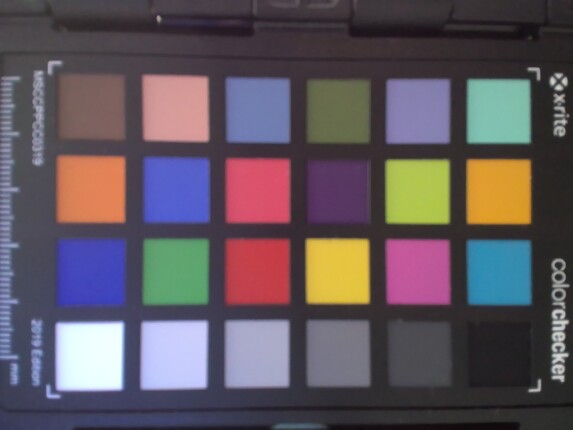
Urządzenia wejściowe - ekran dotykowy i klawiatura Bluetooth
W zestawie znajduje się kompaktowa klawiatura Bluetooth ze zintegrowanym clickpadem, którą można magnetycznie przymocować do tabletu, co pozwala użytkownikom na transportowanie zarówno jej, jak i urządzenia razem. Pisanie na niej jest przyzwoite dzięki skokowi klawiszy wynoszącemu 1,4 mm, ale klawiatura nie jest niestety podświetlana, co ma zauważalne konsekwencje w praktycznym użytkowaniu. Podczas gdy clickpad (10,5 x 6,2 cm / ~4,13 x 2,44 in) jest również przyzwoity i niezawodnie rozpoznaje gesty, kliknięcia są nieco głośne. Klawiaturę można ładować przez USB-C.
Do wprowadzania danych służy oczywiście także pojemnościowy ekran dotykowy. Jednak oficjalny brak obsługi rysika według Asusa jest sporym ograniczeniem. Producent uzasadnia to zapobieganiem uszkodzeniom powierzchni ekranu, który w przeciwieństwie do tradycyjnych ekranów dotykowych pozbawiony jest dodatkowych warstw ochronnych. Na naszym testowym urządzeniu (które służyło jako urządzenie demonstracyjne na IFA) widać lekkie wgniecenie powierzchni wyświetlacza z uszkodzonymi pikselami. Zatem coś w tym twierdzeniu może być, a użytkownicy powinni obchodzić się z Zenbookiem 17 Fold ostrożnie. Podobnie jak w przypadku innych smartfonów i tabletów, nadal można używać zwykłych piór z gumową końcówką.
Wyświetlacz - 17-zolowy OLED o proporcjach 4:3
17-calowy ekran dotykowy OLED ma rozdzielczość 2560 x 1920 pikseli i proporcje 4:3. Choć sprawia on znakomite subiektywne wrażenie, linia zagięcia na środku może stać się zauważalna w zależności od kąta patrzenia i refleksów podobnie jak w innych składanych urządzeniach (np. smartfonach). Obraz nie jest jednak zniekształcony i w praktyce nie jest to rozpraszające. The Fold nie oferuje szybkiej częstotliwości odświeżania. Kąty widzenia są świetne, a dzięki panelowi OLED nie występuje backlight bleeding. Asus dołącza kilka funkcji przeciwdziałających wypalaniu się od statycznych obrazów. Należy do nich włączenie wygaszacza ekranu po 30 minutach bezczynności, a także pixel shift, który bardzo nieznacznie przesuwa piksele. W praktyce nie jest to zauważalne. Poza jasnością można też automatycznie regulować temperaturę barwową za pomocą czujnika światła otoczenia.
Wyniki pomiarów jasności odpowiadają naszym oczekiwaniom dla obecnych paneli OLED w urządzeniach mobilnych. Zmierzyliśmy około 330 nitów w trybie SDR, choć współczynnik kontrastu jest nadal bardzo wysoki ze względu na niską wartość czerni. Tryb HDR (który trzeba ręcznie włączyć poprzez ustawienia) pozwala na uzyskanie jasności do 560 nitów w niewielkich fragmentach ekranu. Podczas wyświetlania niemal całkowicie jasnego obrazu wartość ta spada do ~380 nitów.
| |||||||||||||||||||||||||
rozświetlenie: 95 %
na akumulatorze: 332 cd/m²
kontrast: 33300:1 (czerń: 0.01 cd/m²)
ΔE ColorChecker Calman: 3.2 | ∀{0.5-29.43 Ø4.78}
ΔE Greyscale Calman: 1.5 | ∀{0.09-98 Ø5}
99.6% AdobeRGB 1998 (Argyll 3D)
100% sRGB (Argyll 3D)
99.9% Display P3 (Argyll 3D)
Gamma: 2.21
CCT: 6583 K
| Asus Zenbook 17 Fold UX9702 BOE9C40, OLED, 2560x1920, 17.3" | Lenovo Yoga 7 16IAP7 Lenovo LEN160WQXGA, IPS, 2560x1600, 16" | LG Gram 16 2-in-1 16T90P LG Philips LP160WQ1-SPA1, IPS, 2560x1600, 16" | Microsoft Surface Book 3 15 LG Philips LGD0554, IPS, 3240x2160, 15" | |
|---|---|---|---|---|
| Display | -22% | -6% | -27% | |
| Display P3 Coverage (%) | 99.9 | 67 -33% | 96.3 -4% | 61.5 -38% |
| sRGB Coverage (%) | 100 | 95.7 -4% | 99.9 0% | 92.7 -7% |
| AdobeRGB 1998 Coverage (%) | 99.6 | 69.3 -30% | 84.7 -15% | 63.6 -36% |
| Response Times | -2655% | -2766% | -2754% | |
| Response Time Grey 50% / Grey 80% * (ms) | 1.12 ? | 36 ? -3114% | 36.4 ? -3150% | 38 ? -3293% |
| Response Time Black / White * (ms) | 1.08 ? | 24.8 ? -2196% | 26.8 ? -2381% | 25 ? -2215% |
| PWM Frequency (Hz) | 240 ? | 250 ? | ||
| Screen | -468% | -500% | -299% | |
| Brightness middle (cd/m²) | 333 | 393.7 18% | 325.3 -2% | 428 29% |
| Brightness (cd/m²) | 327 | 367 12% | 311 -5% | 413 26% |
| Brightness Distribution (%) | 95 | 84 -12% | 92 -3% | 89 -6% |
| Black Level * (cd/m²) | 0.01 | 0.38 -3700% | 0.35 -3400% | 0.23 -2200% |
| Contrast (:1) | 33300 | 1036 -97% | 929 -97% | 1861 -94% |
| Colorchecker dE 2000 * | 3.2 | 1.97 38% | 4.91 -53% | 2.65 17% |
| Colorchecker dE 2000 max. * | 8.6 | 5.46 37% | 10.96 -27% | 8.12 6% |
| Greyscale dE 2000 * | 1.5 | 2.1 -40% | 7.7 -413% | 3.99 -166% |
| Gamma | 2.21 100% | 2.1 105% | 2.12 104% | 3.12 71% |
| CCT | 6583 99% | 6461 101% | 8272 79% | 6309 103% |
| Colorchecker dE 2000 calibrated * | 0.62 | 2.83 | 0.92 | |
| Color Space (Percent of AdobeRGB 1998) (%) | 75.8 | 58 | ||
| Color Space (Percent of sRGB) (%) | 99.8 | 93 | ||
| Całkowita średnia (program / ustawienia) | -1048% /
-702% | -1091% /
-735% | -1027% /
-614% |
* ... im mniej tym lepiej
Aplikacja MyAsus zawiera wiele profili (sRGB, P3), przy czym domyślnym ustawieniem jest "Native". Na początku skala szarości wygląda bardzo obiecująco z niskimi odchyleniami od referencyjnej przestrzeni barw P3 i temperaturą barwową, która bardzo zbliża się do wartości idealnej. Niestety, w naszej profesjonalnej analizie (X-Rite i1 Pro 2) z oprogramowaniem CalMAN odkryliśmy znaczne odchylenia kolorystyczne, które pozostają obecne we wszystkich innych trybach.
Ponieważ nie byliśmy w stanie złagodzić problemów z odchyleniami kolorów poprzez naszą próbę kalibracji, nie możemy tutaj przedstawić odpowiedniego profilu. Podczas gdy panel OLED nadal dobrze nadaje się do codziennego użytku, odchylenia kolorów są zbyt duże do poważnej pracy przy edycji mediów. Przestrzeń kolorów P3 może być wyświetlana w całości.
Wyświetl czasy reakcji
| ↔ Czas reakcji od czerni do bieli | ||
|---|---|---|
| 1.08 ms ... wzrost ↗ i spadek ↘ łącznie | ↗ 0.55 ms wzrost | |
| ↘ 0.53 ms upadek | ||
| W naszych testach ekran wykazuje bardzo szybką reakcję i powinien bardzo dobrze nadawać się do szybkich gier. Dla porównania, wszystkie testowane urządzenia wahają się od 0.1 (minimum) do 240 (maksimum) ms. » 4 % wszystkich urządzeń jest lepszych. Oznacza to, że zmierzony czas reakcji jest lepszy od średniej wszystkich testowanych urządzeń (20.2 ms). | ||
| ↔ Czas reakcji 50% szarości do 80% szarości | ||
| 1.12 ms ... wzrost ↗ i spadek ↘ łącznie | ↗ 0.56 ms wzrost | |
| ↘ 0.56 ms upadek | ||
| W naszych testach ekran wykazuje bardzo szybką reakcję i powinien bardzo dobrze nadawać się do szybkich gier. Dla porównania, wszystkie testowane urządzenia wahają się od 0.165 (minimum) do 636 (maksimum) ms. » 4 % wszystkich urządzeń jest lepszych. Oznacza to, że zmierzony czas reakcji jest lepszy od średniej wszystkich testowanych urządzeń (31.6 ms). | ||
Migotanie ekranu / PWM (modulacja szerokości impulsu)
| Wykryto migotanie ekranu/wykryto PWM | 240 Hz | ≤ 65 % ustawienia jasności | |
Podświetlenie wyświetlacza miga z częstotliwością 240 Hz (najgorszy przypadek, np. przy użyciu PWM) Wykryto migotanie przy ustawieniu jasności 65 % i poniżej. Powyżej tego ustawienia jasności nie powinno być żadnego migotania ani PWM. Częstotliwość 240 Hz jest stosunkowo niska, więc wrażliwi użytkownicy prawdopodobnie zauważą migotanie i odczują zmęczenie oczu przy podanym ustawieniu jasności i poniżej. Dla porównania: 53 % wszystkich testowanych urządzeń nie używa PWM do przyciemniania wyświetlacza. Jeśli wykryto PWM, zmierzono średnio 8108 (minimum: 5 - maksimum: 343500) Hz. | |||
Poczyniliśmy kilka godnych uwagi obserwacji dotyczących migotania PWM. Typowe i potencjalnie rozpraszające migotanie 240 Hz jest obecne na wszystkich poziomach jasności od 0 do 65%. Od 66 do 99% używane jest ściemnianie DC, a przy 100% jasności nie odnotowaliśmy żadnego migotania. Chociaż częstotliwość przyciemniania DC wynosi tylko 60 Hz, mała amplituda sprawia, że migotanie jest znacznie mniej problematyczne.
Podobnie jak w innych urządzeniach Asusa z panelami OLED, istnieje funkcja oprogramowania o nazwie flicker-free OLED, która redukuje migotanie nawet przy niższych ustawieniach jasności. Gdy tylko użytkownik zmniejszy jasność, pojawia się podpowiedź, aby unikać ustawiania normalnej jasności Windows poniżej 60%, a zamiast tego użyć oprogramowania do dalszego zmniejszania luminancji panelu krok po kroku. Dzięki temu DC dimming pozostaje włączony, aby uniknąć problematycznego migotania przy 240 Hz. Wbrew zaleceniom Asusa należy jednak pozwolić, by jasność systemu Windows spadła poniżej 70 %. Funkcja działa, choć w pełni zintegrowane rozwiązanie byłoby mniej kłopotliwe.
Użytkowanie na zewnątrz zależy w dużej mierze od tego, jak jasne jest otoczenie i czy świeci słońce. W pochmurne dni odbicia są nadal zauważalne, ale zazwyczaj wszystko na ekranie pozostaje dostrzegalne. Pod światło słoneczne problemem może stać się stosunkowo niska jasność SDR, gdyż nie jest ona w stanie odpowiednio skompensować refleksów i odblasków.
Wydajność - Zenbook 17 Fold z energooszczędnym procesorem Alder Lake
Asus oferuje obecnie tylko jedną konfigurację modelu Zenbook 17 Fold, która posiada procesor Intel Core i7, 16 GB pamięci RAM i dysk SSD PCIe o pojemności 1 TB. Zamiast zwykłego układu Alder Lake-U, laptop opiera się na szczególnie energooszczędnym chipie (wcześniej nazwanym ULV). Według Intela Core i7-1250U osiąga szczytowe zużycie energii na poziomie 29 W, a typowe TDP wynosi zaledwie 9 W.
Warunki badania
W aplikacji MyAsus można wybrać różne profile zasilania (tryb cichy, tryb standardowy, tryb wydajnościowy), przy czym tryb standardowy jest domyślny. Choć wszystkie trzy profile są generalnie odpowiednie do codziennego użytku, tryb wydajnościowy jest zalecany do gier, gdyż występują w nim znaczne różnice w wydajności GPU. W tym trybie wentylatory są jednak bardziej głośne. Poniższa tabela przedstawia odpowiednie wartości TDP. Chociaż wszystkie benchmarki i pomiary przeprowadziliśmy przy użyciu trybu wydajnościowego, w razie potrzeby określimy również wpływ pozostałych trybów.
| Profil zasilania | CPU PL2 | CPU PL1 | Szczytowy hałas wentylatora |
|---|---|---|---|
| Tryb cichy | 29 watów | ~10,5 watów | niezauważalny |
| Tryb standardowy | 29 watów | ~14 watów | 27,9 dB(A) |
| Tryb wydajności | 29 watów | ~16 watów | 43,4 dB(A) |
Procesor - Intel Core i7-1250U
Na stronie Core i7-1250U to procesor Alder Lake-U z dwoma szybkimi rdzeniami wydajnościowymi i ośmioma wydajnymi (łącznie 10 rdzeni i 12 wątków). Limity mocy w porównaniu z "normalnym" Core i7-1255U są jednak niższe i Asus trzyma się specyfikacji Intela dotyczącej 29-watowego szczytowego poboru mocy. Pod dłuższym obciążeniem pobór mocy utrzymuje się w przedziale 16-16 W, co jest całkiem przyzwoitym wynikiem, biorąc pod uwagę presety TDP. Po ustawieniu trybu standardowego wydajność procesora bardzo nieznacznie spada, co - w przeciwieństwie do cichszego wentylatora - nie jest zauważalne. W trybie akumulatorowym wydajność pozostaje niezmienna; dodatkowe benchmarki CPU można znaleźć na naszej stronie Strona z benchmarkami CPU.
Cinebench R15 Multi Loop
Cinebench R23: Multi Core | Single Core
Cinebench R20: CPU (Multi Core) | CPU (Single Core)
Cinebench R15: CPU Multi 64Bit | CPU Single 64Bit
Blender: v2.79 BMW27 CPU
7-Zip 18.03: 7z b 4 | 7z b 4 -mmt1
Geekbench 5.5: Multi-Core | Single-Core
HWBOT x265 Benchmark v2.2: 4k Preset
LibreOffice : 20 Documents To PDF
R Benchmark 2.5: Overall mean
| CPU Performance rating | |
| Średnia w klasie Convertible | |
| Lenovo Yoga 7 16IAP7 | |
| Asus Zenbook 17 Fold UX9702 | |
| Przeciętny Intel Core i7-1250U | |
| LG Gram 16 2-in-1 16T90P | |
| Microsoft Surface Book 3 15 -2! | |
| Cinebench R23 / Multi Core | |
| Średnia w klasie Convertible (2949 - 29063, n=56, ostatnie 2 lata) | |
| Lenovo Yoga 7 16IAP7 | |
| Przeciętny Intel Core i7-1250U (7021 - 7735, n=3) | |
| Asus Zenbook 17 Fold UX9702 | |
| LG Gram 16 2-in-1 16T90P | |
| Cinebench R23 / Single Core | |
| Lenovo Yoga 7 16IAP7 | |
| Średnia w klasie Convertible (914 - 2163, n=56, ostatnie 2 lata) | |
| Przeciętny Intel Core i7-1250U (1561 - 1606, n=3) | |
| Asus Zenbook 17 Fold UX9702 | |
| LG Gram 16 2-in-1 16T90P | |
| Cinebench R20 / CPU (Multi Core) | |
| Średnia w klasie Convertible (1124 - 11357, n=56, ostatnie 2 lata) | |
| Lenovo Yoga 7 16IAP7 | |
| Przeciętny Intel Core i7-1250U (2745 - 2970, n=3) | |
| Asus Zenbook 17 Fold UX9702 | |
| LG Gram 16 2-in-1 16T90P | |
| Microsoft Surface Book 3 15 | |
| Cinebench R20 / CPU (Single Core) | |
| Średnia w klasie Convertible (348 - 827, n=56, ostatnie 2 lata) | |
| Lenovo Yoga 7 16IAP7 | |
| Asus Zenbook 17 Fold UX9702 | |
| Przeciętny Intel Core i7-1250U (605 - 621, n=3) | |
| LG Gram 16 2-in-1 16T90P | |
| Microsoft Surface Book 3 15 | |
| Cinebench R15 / CPU Multi 64Bit | |
| Średnia w klasie Convertible (478 - 4830, n=59, ostatnie 2 lata) | |
| Lenovo Yoga 7 16IAP7 | |
| Asus Zenbook 17 Fold UX9702 | |
| Asus Zenbook 17 Fold UX9702 | |
| Przeciętny Intel Core i7-1250U (1085 - 1297, n=4) | |
| LG Gram 16 2-in-1 16T90P | |
| Microsoft Surface Book 3 15 | |
| Cinebench R15 / CPU Single 64Bit | |
| Średnia w klasie Convertible (149.8 - 317, n=56, ostatnie 2 lata) | |
| Lenovo Yoga 7 16IAP7 | |
| Asus Zenbook 17 Fold UX9702 | |
| Przeciętny Intel Core i7-1250U (218 - 226, n=3) | |
| LG Gram 16 2-in-1 16T90P | |
| Microsoft Surface Book 3 15 | |
| Blender / v2.79 BMW27 CPU | |
| Microsoft Surface Book 3 15 | |
| LG Gram 16 2-in-1 16T90P | |
| Asus Zenbook 17 Fold UX9702 | |
| Przeciętny Intel Core i7-1250U (411 - 556, n=3) | |
| Lenovo Yoga 7 16IAP7 | |
| Średnia w klasie Convertible (107 - 1051, n=55, ostatnie 2 lata) | |
| 7-Zip 18.03 / 7z b 4 | |
| Lenovo Yoga 7 16IAP7 | |
| Średnia w klasie Convertible (12977 - 121368, n=56, ostatnie 2 lata) | |
| Asus Zenbook 17 Fold UX9702 | |
| Przeciętny Intel Core i7-1250U (27072 - 31934, n=3) | |
| LG Gram 16 2-in-1 16T90P | |
| Microsoft Surface Book 3 15 | |
| 7-Zip 18.03 / 7z b 4 -mmt1 | |
| Lenovo Yoga 7 16IAP7 | |
| Średnia w klasie Convertible (3672 - 6540, n=56, ostatnie 2 lata) | |
| LG Gram 16 2-in-1 16T90P | |
| Przeciętny Intel Core i7-1250U (4755 - 5041, n=3) | |
| Asus Zenbook 17 Fold UX9702 | |
| Microsoft Surface Book 3 15 | |
| Geekbench 5.5 / Multi-Core | |
| Lenovo Yoga 7 16IAP7 | |
| Średnia w klasie Convertible (2188 - 22023, n=55, ostatnie 2 lata) | |
| Asus Zenbook 17 Fold UX9702 | |
| Przeciętny Intel Core i7-1250U (6753 - 7092, n=3) | |
| LG Gram 16 2-in-1 16T90P | |
| Microsoft Surface Book 3 15 | |
| Geekbench 5.5 / Single-Core | |
| Średnia w klasie Convertible (806 - 2275, n=55, ostatnie 2 lata) | |
| Lenovo Yoga 7 16IAP7 | |
| Asus Zenbook 17 Fold UX9702 | |
| Przeciętny Intel Core i7-1250U (1584 - 1670, n=3) | |
| LG Gram 16 2-in-1 16T90P | |
| Microsoft Surface Book 3 15 | |
| HWBOT x265 Benchmark v2.2 / 4k Preset | |
| Średnia w klasie Convertible (3.43 - 36.2, n=56, ostatnie 2 lata) | |
| Lenovo Yoga 7 16IAP7 | |
| Przeciętny Intel Core i7-1250U (7.84 - 8.97, n=3) | |
| Asus Zenbook 17 Fold UX9702 | |
| LG Gram 16 2-in-1 16T90P | |
| Microsoft Surface Book 3 15 | |
| LibreOffice / 20 Documents To PDF | |
| Microsoft Surface Book 3 15 | |
| Przeciętny Intel Core i7-1250U (51.8 - 53.8, n=3) | |
| Średnia w klasie Convertible (42.5 - 84.3, n=55, ostatnie 2 lata) | |
| Asus Zenbook 17 Fold UX9702 | |
| LG Gram 16 2-in-1 16T90P | |
| Lenovo Yoga 7 16IAP7 | |
| R Benchmark 2.5 / Overall mean | |
| Microsoft Surface Book 3 15 | |
| LG Gram 16 2-in-1 16T90P | |
| Przeciętny Intel Core i7-1250U (0.504 - 0.538, n=3) | |
| Asus Zenbook 17 Fold UX9702 | |
| Średnia w klasie Convertible (0.3985 - 0.84, n=55, ostatnie 2 lata) | |
| Lenovo Yoga 7 16IAP7 | |
* ... im mniej tym lepiej
AIDA64: FP32 Ray-Trace | FPU Julia | CPU SHA3 | CPU Queen | FPU SinJulia | FPU Mandel | CPU AES | CPU ZLib | FP64 Ray-Trace | CPU PhotoWorxx
| Performance rating | |
| Średnia w klasie Convertible | |
| Lenovo Yoga 7 16IAP7 | |
| LG Gram 16 2-in-1 16T90P | |
| Asus Zenbook 17 Fold UX9702 | |
| Przeciętny Intel Core i7-1250U | |
| Microsoft Surface Book 3 15 | |
| AIDA64 / FP32 Ray-Trace | |
| Średnia w klasie Convertible (1480 - 64158, n=55, ostatnie 2 lata) | |
| Lenovo Yoga 7 16IAP7 | |
| LG Gram 16 2-in-1 16T90P | |
| Przeciętny Intel Core i7-1250U (5093 - 7187, n=3) | |
| Asus Zenbook 17 Fold UX9702 | |
| Microsoft Surface Book 3 15 | |
| AIDA64 / FPU Julia | |
| Średnia w klasie Convertible (11392 - 183760, n=55, ostatnie 2 lata) | |
| Lenovo Yoga 7 16IAP7 | |
| Asus Zenbook 17 Fold UX9702 | |
| Przeciętny Intel Core i7-1250U (25253 - 35312, n=3) | |
| LG Gram 16 2-in-1 16T90P | |
| Microsoft Surface Book 3 15 | |
| AIDA64 / CPU SHA3 | |
| Średnia w klasie Convertible (797 - 8151, n=55, ostatnie 2 lata) | |
| Lenovo Yoga 7 16IAP7 | |
| LG Gram 16 2-in-1 16T90P | |
| Asus Zenbook 17 Fold UX9702 | |
| Przeciętny Intel Core i7-1250U (1296 - 1840, n=3) | |
| Microsoft Surface Book 3 15 | |
| AIDA64 / CPU Queen | |
| Lenovo Yoga 7 16IAP7 | |
| Średnia w klasie Convertible (14686 - 145339, n=55, ostatnie 2 lata) | |
| Przeciętny Intel Core i7-1250U (53235 - 53961, n=3) | |
| Asus Zenbook 17 Fold UX9702 | |
| LG Gram 16 2-in-1 16T90P | |
| Microsoft Surface Book 3 15 | |
| AIDA64 / FPU SinJulia | |
| Średnia w klasie Convertible (1120 - 29155, n=55, ostatnie 2 lata) | |
| Lenovo Yoga 7 16IAP7 | |
| LG Gram 16 2-in-1 16T90P | |
| Przeciętny Intel Core i7-1250U (3617 - 4347, n=3) | |
| Asus Zenbook 17 Fold UX9702 | |
| Microsoft Surface Book 3 15 | |
| AIDA64 / FPU Mandel | |
| Średnia w klasie Convertible (4929 - 97193, n=55, ostatnie 2 lata) | |
| Lenovo Yoga 7 16IAP7 | |
| LG Gram 16 2-in-1 16T90P | |
| Asus Zenbook 17 Fold UX9702 | |
| Przeciętny Intel Core i7-1250U (12480 - 17594, n=3) | |
| Microsoft Surface Book 3 15 | |
| AIDA64 / CPU AES | |
| LG Gram 16 2-in-1 16T90P | |
| Średnia w klasie Convertible (15752 - 139734, n=55, ostatnie 2 lata) | |
| Lenovo Yoga 7 16IAP7 | |
| Asus Zenbook 17 Fold UX9702 | |
| Przeciętny Intel Core i7-1250U (26729 - 36135, n=3) | |
| Microsoft Surface Book 3 15 | |
| AIDA64 / CPU ZLib | |
| Średnia w klasie Convertible (218 - 2001, n=55, ostatnie 2 lata) | |
| Lenovo Yoga 7 16IAP7 | |
| Asus Zenbook 17 Fold UX9702 | |
| Przeciętny Intel Core i7-1250U (391 - 550, n=3) | |
| LG Gram 16 2-in-1 16T90P | |
| Microsoft Surface Book 3 15 | |
| AIDA64 / FP64 Ray-Trace | |
| Średnia w klasie Convertible (1169 - 34297, n=55, ostatnie 2 lata) | |
| Lenovo Yoga 7 16IAP7 | |
| LG Gram 16 2-in-1 16T90P | |
| Przeciętny Intel Core i7-1250U (2687 - 3755, n=3) | |
| Asus Zenbook 17 Fold UX9702 | |
| Microsoft Surface Book 3 15 | |
| AIDA64 / CPU PhotoWorxx | |
| LG Gram 16 2-in-1 16T90P | |
| Średnia w klasie Convertible (14193 - 81626, n=55, ostatnie 2 lata) | |
| Lenovo Yoga 7 16IAP7 | |
| Asus Zenbook 17 Fold UX9702 | |
| Przeciętny Intel Core i7-1250U (31653 - 36020, n=3) | |
| Microsoft Surface Book 3 15 | |
Wydajność systemu
Podczas codziennego użytkowania Zenbook 17 Fold jest urządzeniem responsywnym częściowo za sprawą szybkiego dysku SSD PCIe. Wyniki benchmarków też są przyzwoite. Wyniki benchmarków są również przyzwoite. Fakt, że system Windows nie został zoptymalizowany pod kątem obsługi dotykowej, szybko staje się widoczny w praktyce. To powiedziawszy, nastąpił znaczny postęp od czasu Windows 10 i starszych ThinkPad X1 Fold i rozkład okien na ekranach jest w Asusie wyraźnie lepszy. Przełączanie się w tryb laptopa po umieszczeniu klawiatury na spodzie (co wyłącza ekran w tym obszarze) działa dobrze, a rozmieszczenie ikon pulpitu pozostaje spójne. Jedynie okna często muszą być zmieniane pod względem rozmiaru, a aktywne aplikacje nie zawsze zmieniają swój rozmiar.
CrossMark: Overall | Productivity | Creativity | Responsiveness
| PCMark 10 / Score | |
| Średnia w klasie Convertible (3229 - 9125, n=53, ostatnie 2 lata) | |
| Lenovo Yoga 7 16IAP7 | |
| Asus Zenbook 17 Fold UX9702 | |
| Przeciętny Intel Core i7-1250U, Intel Iris Xe Graphics G7 80EUs (n=1) | |
| LG Gram 16 2-in-1 16T90P | |
| Microsoft Surface Book 3 15 | |
| PCMark 10 / Essentials | |
| Lenovo Yoga 7 16IAP7 | |
| Średnia w klasie Convertible (7233 - 12222, n=53, ostatnie 2 lata) | |
| Asus Zenbook 17 Fold UX9702 | |
| Przeciętny Intel Core i7-1250U, Intel Iris Xe Graphics G7 80EUs (n=1) | |
| LG Gram 16 2-in-1 16T90P | |
| Microsoft Surface Book 3 15 | |
| PCMark 10 / Productivity | |
| Średnia w klasie Convertible (5062 - 10643, n=53, ostatnie 2 lata) | |
| Lenovo Yoga 7 16IAP7 | |
| Asus Zenbook 17 Fold UX9702 | |
| Przeciętny Intel Core i7-1250U, Intel Iris Xe Graphics G7 80EUs (n=1) | |
| LG Gram 16 2-in-1 16T90P | |
| Microsoft Surface Book 3 15 | |
| PCMark 10 / Digital Content Creation | |
| Średnia w klasie Convertible (2496 - 16551, n=53, ostatnie 2 lata) | |
| Lenovo Yoga 7 16IAP7 | |
| LG Gram 16 2-in-1 16T90P | |
| Asus Zenbook 17 Fold UX9702 | |
| Przeciętny Intel Core i7-1250U, Intel Iris Xe Graphics G7 80EUs (n=1) | |
| Microsoft Surface Book 3 15 | |
| CrossMark / Overall | |
| Lenovo Yoga 7 16IAP7 | |
| Średnia w klasie Convertible (524 - 2274, n=56, ostatnie 2 lata) | |
| Asus Zenbook 17 Fold UX9702 | |
| Przeciętny Intel Core i7-1250U, Intel Iris Xe Graphics G7 80EUs (n=1) | |
| CrossMark / Productivity | |
| Lenovo Yoga 7 16IAP7 | |
| Średnia w klasie Convertible (554 - 1925, n=56, ostatnie 2 lata) | |
| Asus Zenbook 17 Fold UX9702 | |
| Przeciętny Intel Core i7-1250U, Intel Iris Xe Graphics G7 80EUs (n=1) | |
| CrossMark / Creativity | |
| Lenovo Yoga 7 16IAP7 | |
| Średnia w klasie Convertible (550 - 2949, n=56, ostatnie 2 lata) | |
| Asus Zenbook 17 Fold UX9702 | |
| Przeciętny Intel Core i7-1250U, Intel Iris Xe Graphics G7 80EUs (n=1) | |
| CrossMark / Responsiveness | |
| Lenovo Yoga 7 16IAP7 | |
| Średnia w klasie Convertible (381 - 1719, n=56, ostatnie 2 lata) | |
| Asus Zenbook 17 Fold UX9702 | |
| Przeciętny Intel Core i7-1250U, Intel Iris Xe Graphics G7 80EUs (n=1) | |
| PCMark 10 Score | 4998 pkt. | |
Pomoc | ||
| AIDA64 / Memory Copy | |
| Średnia w klasie Convertible (23880 - 158525, n=55, ostatnie 2 lata) | |
| Lenovo Yoga 7 16IAP7 | |
| LG Gram 16 2-in-1 16T90P | |
| Asus Zenbook 17 Fold UX9702 | |
| Przeciętny Intel Core i7-1250U (54484 - 61468, n=3) | |
| Microsoft Surface Book 3 15 | |
| AIDA64 / Memory Read | |
| Średnia w klasie Convertible (19931 - 126725, n=55, ostatnie 2 lata) | |
| Lenovo Yoga 7 16IAP7 | |
| LG Gram 16 2-in-1 16T90P | |
| Przeciętny Intel Core i7-1250U (50867 - 56328, n=3) | |
| Microsoft Surface Book 3 15 | |
| Asus Zenbook 17 Fold UX9702 | |
| AIDA64 / Memory Write | |
| Średnia w klasie Convertible (17473 - 216896, n=55, ostatnie 2 lata) | |
| LG Gram 16 2-in-1 16T90P | |
| Przeciętny Intel Core i7-1250U (59356 - 65429, n=3) | |
| Asus Zenbook 17 Fold UX9702 | |
| Lenovo Yoga 7 16IAP7 | |
| Microsoft Surface Book 3 15 | |
| AIDA64 / Memory Latency | |
| Asus Zenbook 17 Fold UX9702 | |
| Średnia w klasie Convertible (6.9 - 536, n=54, ostatnie 2 lata) | |
| Przeciętny Intel Core i7-1250U (89.3 - 145.7, n=3) | |
| Lenovo Yoga 7 16IAP7 | |
| LG Gram 16 2-in-1 16T90P | |
| Microsoft Surface Book 3 15 | |
* ... im mniej tym lepiej
Opóźnienie DPC
| DPC Latencies / LatencyMon - interrupt to process latency (max), Web, Youtube, Prime95 | |
| Microsoft Surface Book 3 15 | |
| LG Gram 16 2-in-1 16T90P | |
| Lenovo Yoga 7 16IAP7 | |
| Asus Zenbook 17 Fold UX9702 | |
* ... im mniej tym lepiej
Rozwiązanie w zakresie przechowywania
Asus zastosował szybki dysk SSD Samsung PCIe-4.0 (PM9A1) o pojemności 1 TB. Po pierwszym skonfigurowaniu urządzenia do dyspozycji użytkownika jest około 905 GB. O ile transfery są znakomite i wynoszą powyżej 6 GB/s, o tyle wydajność drastycznie spada już po kilku minutach. Nie powinno to wpływać na normalne użytkowanie i podczas naszych testów nie zauważyliśmy żadnych ograniczeń. Ograniczenia temperaturowe są prawdopodobnym winowajcą problemów i problemem dużej części szybkich dysków SSD PCIe-4.0. Dodatkowe benchmarki SSD można tutaj.
| Drive Performance rating - Percent | |
| Przeciętny Samsung PM9A1 MZVL21T0HCLR | |
| Asus Zenbook 17 Fold UX9702 | |
| Średnia w klasie Convertible | |
| LG Gram 16 2-in-1 16T90P | |
| Lenovo Yoga 7 16IAP7 | |
| Microsoft Surface Book 3 15 | |
* ... im mniej tym lepiej
Disk Throttling: DiskSpd Read Loop, Queue Depth 8
Wydajność GPU
Jedną z osobliwości jest m.in Core i7-1250U jest jego nieco wolniejsze iGPU, a konkretnie Iris Xe Graphics G7 z 80 EUs (taktowanie rdzenia do 950 MHz), który jest również zintegrowany w wielu procesorach Core i5. Podczas codziennego użytkowania wydajność jest nadal wystarczająca i bez problemu można oglądać filmy w wysokiej rozdzielczości. Ponieważ Zenbook 17 Fold zmaga się z płynnym uruchamianiem wielu tytułów nawet na niskich ustawieniach, ledwo nadaje się do gier. Użytkownikom, którzy chcą grać, polecamy tryb wydajności, ponieważ w innych trybach wydajność GPU spada o około 50%. Do gier w domu można podłączyć zewnętrzne GPU przez Thunderbolt, choć należy zauważyć, że procesor może stać się wąskim gardłem dla szybszych rozwiązań zewnętrznych.
Wydajność GPU jest spójna zarówno pod długotrwałym obciążeniem, jak i w trybie bateryjnym. Dodatkowe benchmarki GPU są dostępne tutaj.
| 3DMark Performance rating - Percent | |
| Microsoft Surface Book 3 15 | |
| Średnia w klasie Convertible | |
| LG Gram 16 2-in-1 16T90P | |
| Lenovo Yoga 7 16IAP7 | |
| Asus Zenbook 17 Fold UX9702 | |
| Przeciętny Intel Iris Xe Graphics G7 80EUs | |
| 3DMark 11 - 1280x720 Performance GPU | |
| Microsoft Surface Book 3 15 | |
| Średnia w klasie Convertible (1505 - 40732, n=55, ostatnie 2 lata) | |
| LG Gram 16 2-in-1 16T90P | |
| Lenovo Yoga 7 16IAP7 | |
| Przeciętny Intel Iris Xe Graphics G7 80EUs (2246 - 6579, n=111) | |
| Asus Zenbook 17 Fold UX9702 | |
| 3DMark | |
| 1280x720 Cloud Gate Standard Graphics | |
| Microsoft Surface Book 3 15 | |
| Średnia w klasie Convertible (7885 - 57566, n=37, ostatnie 2 lata) | |
| LG Gram 16 2-in-1 16T90P | |
| Lenovo Yoga 7 16IAP7 | |
| Asus Zenbook 17 Fold UX9702 | |
| Przeciętny Intel Iris Xe Graphics G7 80EUs (6361 - 30894, n=96) | |
| 1920x1080 Fire Strike Graphics | |
| Microsoft Surface Book 3 15 | |
| Średnia w klasie Convertible (1185 - 25992, n=56, ostatnie 2 lata) | |
| LG Gram 16 2-in-1 16T90P | |
| Lenovo Yoga 7 16IAP7 | |
| Asus Zenbook 17 Fold UX9702 | |
| Przeciętny Intel Iris Xe Graphics G7 80EUs (1560 - 5398, n=113) | |
| 2560x1440 Time Spy Graphics | |
| Microsoft Surface Book 3 15 | |
| Średnia w klasie Convertible (327 - 10224, n=55, ostatnie 2 lata) | |
| LG Gram 16 2-in-1 16T90P | |
| Lenovo Yoga 7 16IAP7 | |
| Asus Zenbook 17 Fold UX9702 | |
| Przeciętny Intel Iris Xe Graphics G7 80EUs (561 - 1576, n=110) | |
| 3DMark 11 Performance | 5407 pkt. | |
| 3DMark Cloud Gate Standard Score | 17149 pkt. | |
| 3DMark Fire Strike Score | 3379 pkt. | |
| 3DMark Time Spy Score | 1474 pkt. | |
Pomoc | ||
Witcher 3 FPS Graph
| low | med. | high | ultra | |
|---|---|---|---|---|
| GTA V (2015) | 75.1 | 44.1 | 8.19 | |
| The Witcher 3 (2015) | 73 | 47 | 25 | 9.47 |
| Dota 2 Reborn (2015) | 34 | 21.1 | 10.4 | 9.3 |
| Final Fantasy XV Benchmark (2018) | 16 | 4.47 | 4.01 | |
| X-Plane 11.11 (2018) | 23.7 | 13.7 | ||
| Far Cry 5 (2018) | 14 | 9 | ||
| Strange Brigade (2018) | 22.7 | 6 | ||
| F1 2021 (2021) | 15.6 | |||
| Farming Simulator 22 (2021) | 16 | |||
| F1 22 (2022) | 11 |
Emisje - Zenbook Fold pozostaje bardzo cichy
Emisja hałasu
Zenbook 17 Fold jest generalnie bardzo cichy - wentylatory szepczą na poziomie ~28 dB(A) w maksymalnym obciążeniu, gdy ustawiony jest tryb standardowy, i w spoczynku, gdy ustawiony jest tryb cichy. Podczas grania tryb wydajności jest w zasadzie obowiązkowy, co skutkuje bardzo zauważalnym poziomem 43 dB(A). Nie zauważyliśmy żadnych elektronicznych szumów ani wycieku cewki.
Hałas
| luz |
| 24.3 / 24.3 / 24.3 dB |
| obciążenie |
| 27.9 / 43.4 dB |
 | ||
30 dB cichy 40 dB(A) słyszalny 50 dB(A) irytujący |
||
min: | ||
| Asus Zenbook 17 Fold UX9702 Iris Xe G7 80EUs, i7-1250U, Samsung PM9A1 MZVL21T0HCLR | Lenovo Yoga 7 16IAP7 Iris Xe G7 96EUs, i7-1260P, Micron 2450 512GB MTFDKCD512TFK | LG Gram 16 2-in-1 16T90P Iris Xe G7 96EUs, i7-1165G7, SK Hynix PC401 512GB M.2 (HFS512GD9TNG) | Microsoft Surface Book 3 15 GeForce GTX 1660 Ti Max-Q, i7-1065G7, SK hynix BC501 HFM256GDGTNG | |
|---|---|---|---|---|
| Noise | -2% | -0% | -14% | |
| wyłączone / środowisko * (dB) | 23.4 | 23.6 -1% | 25.1 -7% | 30.2 -29% |
| Idle Minimum * (dB) | 24.3 | 23.6 3% | 25.2 -4% | 30.2 -24% |
| Idle Average * (dB) | 24.3 | 23.6 3% | 25.2 -4% | 30.2 -24% |
| Idle Maximum * (dB) | 24.3 | 23.6 3% | 25.2 -4% | 30.2 -24% |
| Load Average * (dB) | 27.9 | 37.7 -35% | 32.1 -15% | 30.9 -11% |
| Witcher 3 ultra * (dB) | 43.4 | 40 8% | 34.9 20% | 45.1 -4% |
| Load Maximum * (dB) | 43.4 | 40.2 7% | 37.8 13% | 34.3 21% |
* ... im mniej tym lepiej
Temperatura
Płyta główna, procesor i chłodzenie znajdują się w lewej połowie obudowy (gdy używana jest w trybie tabletu), ale temperatury powierzchni pozostają rozsądne. Temperatury ledwo rosną podczas codziennego użytkowania i nawet w maksymalnym stresie zmierzyliśmy tylko 44 °C (111,2 °F) i ~42 °C (107,6 °F) odpowiednio z przodu i z tyłu. W większości scenariuszy użytkownicy i tak raczej nie będą mieli kontaktu z tymi obszarami, na przykład w trybie laptopa lub gdy tablet jest odłożony na stół.
Podczas naszego testu stresu taktowanie GPU ulega dużym wahaniom, podczas gdy wydajność CPU pozostaje stała. Wydajność nie spada bezpośrednio po teście warunków skrajnych.
(±) Maksymalna temperatura w górnej części wynosi 44.5 °C / 112 F, w porównaniu do średniej 35.4 °C / 96 F , począwszy od 19.6 do 60 °C dla klasy Convertible.
(±) Dno nagrzewa się maksymalnie do 41.8 °C / 107 F, w porównaniu do średniej 36.8 °C / 98 F
(+) W stanie bezczynności średnia temperatura górnej części wynosi 25.2 °C / 77 F, w porównaniu ze średnią temperaturą urządzenia wynoszącą 30.3 °C / ### class_avg_f### F.
(±) Podczas gry w Wiedźmina 3 średnia temperatura górnej części wynosi 34.6 °C / 94 F, w porównaniu do średniej temperatury urządzenia wynoszącej 30.3 °C / ## #class_avg_f### F.
(±) Podpórki pod nadgarstki i touchpad mogą się bardzo nagrzać w dotyku, maksymalnie do 37.8 °C / 100 F.
(-) Średnia temperatura obszaru podparcia dłoni w podobnych urządzeniach wynosiła 27.9 °C / 82.2 F (-9.9 °C / -17.8 F).
| Asus Zenbook 17 Fold UX9702 Intel Core i7-1250U, Intel Iris Xe Graphics G7 80EUs | Lenovo Yoga 7 16IAP7 Intel Core i7-1260P, Intel Iris Xe Graphics G7 96EUs | LG Gram 16 2-in-1 16T90P Intel Core i7-1165G7, Intel Iris Xe Graphics G7 96EUs | Microsoft Surface Book 3 15 Intel Core i7-1065G7, NVIDIA GeForce GTX 1660 Ti Max-Q | |
|---|---|---|---|---|
| Heat | 18% | -2% | -8% | |
| Maximum Upper Side * (°C) | 44.5 | 39 12% | 42.2 5% | 41.4 7% |
| Maximum Bottom * (°C) | 41.8 | 34.2 18% | 46.2 -11% | 39.7 5% |
| Idle Upper Side * (°C) | 28.9 | 21.2 27% | 26 10% | 34.6 -20% |
| Idle Bottom * (°C) | 24.7 | 21.6 13% | 27.6 -12% | 30.3 -23% |
* ... im mniej tym lepiej
Mówcy
Po obu stronach rozmieszczone są cztery głośniki. O ile w trybie tabletu pozwala to na uzyskanie przyzwoitego efektu stereo, o tyle tryb laptopa to już inna historia (gdyż głośniki znajdują się wtedy na górnej i dolnej krawędzi). Do systemu dołączona jest aplikacja Dolby i zalecamy włączenie jej efektów, gdyż w przeciwnym razie dźwięk jest relatywnie cienki. Po włączeniu efektów Dolby (dostępne są różne profile), dźwięk jest przyjemnie pełny i bogaty, a jedynie częstotliwości basowe są bardziej ograniczone. Do okazjonalnego słuchania muzyki i oglądania filmów jakość jest więcej niż wystarczająca i użytkownicy nie będą musieli korzystać z zewnętrznych głośników lub słuchawek.
Asus Zenbook 17 Fold UX9702 analiza dźwięku
(±) | głośność głośnika jest średnia, ale dobra (80 dB)
Bas 100 - 315 Hz
(±) | zredukowany bas - średnio 7.2% niższy od mediany
(±) | liniowość basu jest średnia (10.3% delta do poprzedniej częstotliwości)
Średnie 400 - 2000 Hz
(±) | wyższe średnie - średnio 7.2% wyższe niż mediana
(+) | średnie są liniowe (6.6% delta do poprzedniej częstotliwości)
Wysokie 2–16 kHz
(+) | zrównoważone maksima - tylko 3.3% od mediany
(+) | wzloty są liniowe (6.2% delta do poprzedniej częstotliwości)
Ogólnie 100 - 16.000 Hz
(+) | ogólny dźwięk jest liniowy (14.5% różnicy w stosunku do mediany)
W porównaniu do tej samej klasy
» 22% wszystkich testowanych urządzeń w tej klasie było lepszych, 4% podobnych, 74% gorszych
» Najlepszy miał deltę 6%, średnia wynosiła ###średnia###%, najgorsza wynosiła 57%
W porównaniu do wszystkich testowanych urządzeń
» 18% wszystkich testowanych urządzeń było lepszych, 4% podobnych, 78% gorszych
» Najlepszy miał deltę 4%, średnia wynosiła ###średnia###%, najgorsza wynosiła 134%
Lenovo Yoga 7 16IAP7 analiza dźwięku
(+) | głośniki mogą odtwarzać stosunkowo głośno (84.7 dB)
Bas 100 - 315 Hz
(±) | zredukowany bas - średnio 13.4% niższy od mediany
(±) | liniowość basu jest średnia (8.6% delta do poprzedniej częstotliwości)
Średnie 400 - 2000 Hz
(±) | wyższe średnie - średnio 5.7% wyższe niż mediana
(+) | średnie są liniowe (6.4% delta do poprzedniej częstotliwości)
Wysokie 2–16 kHz
(+) | zrównoważone maksima - tylko 3.9% od mediany
(+) | wzloty są liniowe (6% delta do poprzedniej częstotliwości)
Ogólnie 100 - 16.000 Hz
(+) | ogólny dźwięk jest liniowy (13.2% różnicy w stosunku do mediany)
W porównaniu do tej samej klasy
» 17% wszystkich testowanych urządzeń w tej klasie było lepszych, 3% podobnych, 81% gorszych
» Najlepszy miał deltę 6%, średnia wynosiła ###średnia###%, najgorsza wynosiła 57%
W porównaniu do wszystkich testowanych urządzeń
» 13% wszystkich testowanych urządzeń było lepszych, 3% podobnych, 84% gorszych
» Najlepszy miał deltę 4%, średnia wynosiła ###średnia###%, najgorsza wynosiła 134%
Zarządzanie energią - żywotność baterii cierpi z powodu OLED
Zużycie energii
Duży, 17-calowy ekran OLED pobiera sporo energii i nawet podczas korzystania ze stosunkowo ciemnego domyślnego tła mierzymy szczytowy pobór mocy w stanie spoczynku na poziomie prawie 13 W. Wartość ta znacznie wzrasta, gdy wyświetlane są jaśniejsze obrazy. Zmierzyliśmy chwilowy szczytowy pobór mocy na poziomie 56 watów, który następnie spada pod ciągłym obciążeniem i szybko stabilizuje się na poziomie około 30-35 watów. Dołączona 65-watowa ładowarka jest więcej niż wystarczająca do zasilania i ładowania systemu.
| wyłączony / stan wstrzymania | |
| luz | |
| obciążenie |
|
Legenda:
min: | |
| Asus Zenbook 17 Fold UX9702 i7-1250U, Iris Xe G7 80EUs, Samsung PM9A1 MZVL21T0HCLR, OLED, 2560x1920, 17.3" | Lenovo Yoga 7 16IAP7 i7-1260P, Iris Xe G7 96EUs, Micron 2450 512GB MTFDKCD512TFK, IPS, 2560x1600, 16" | LG Gram 16 2-in-1 16T90P i7-1165G7, Iris Xe G7 96EUs, SK Hynix PC401 512GB M.2 (HFS512GD9TNG), IPS, 2560x1600, 16" | Microsoft Surface Book 3 15 i7-1065G7, GeForce GTX 1660 Ti Max-Q, SK hynix BC501 HFM256GDGTNG, IPS, 3240x2160, 15" | Przeciętny Intel Iris Xe Graphics G7 80EUs | Średnia w klasie Convertible | |
|---|---|---|---|---|---|---|
| Power Consumption | -18% | 2% | -51% | 19% | 12% | |
| Idle Minimum * (Watt) | 7.6 | 6.6 13% | 4.4 42% | 4.2 45% | 4.47 ? 41% | 4.43 ? 42% |
| Idle Average * (Watt) | 12.3 | 8.3 33% | 9 27% | 7.4 40% | 7.37 ? 40% | 7.38 ? 40% |
| Idle Maximum * (Watt) | 12.9 | 9.8 24% | 10.1 22% | 9 30% | 9.24 ? 28% | 9.78 ? 24% |
| Load Average * (Watt) | 35.2 | 66 -88% | 45.5 -29% | 78 -122% | 36.6 ? -4% | 45 ? -28% |
| Witcher 3 ultra * (Watt) | 30.4 | 52 -71% | 39.6 -30% | 94.2 -210% | ||
| Load Maximum * (Watt) | 56.6 | 67.1 -19% | 67 -18% | 108 -91% | 61.7 ? -9% | 67.1 ? -19% |
* ... im mniej tym lepiej
Power Consumption Witcher 3 / Stress Test
Power Consumption External Monitor
Czas pracy na baterii
Czas pracy na baterii może się w praktyce bardzo różnić w zależności od wyświetlanych treści, gdyż ekrany OLED pobierają więcej energii podczas wyświetlania jasnych obrazów. Duża rozbieżność między testem wideo a testem Wi-Fi, który polega głównie na wyświetlaniu jasnych stron internetowych, jest tego najlepszym przykładem. O ile w obu scenariuszach jasność jest ustawiona na 150 nitów (73% maksymalnej jasności w przypadku naszego urządzenia testowego) i czas pracy przy wideo jest znakomity i wynosi 11 godzin, o tyle w teście Wi-Fi bateria wytrzymuje tylko 6:43 godziny. Przy maksymalnej jasności SDR czas pracy spada o kolejne 2 godziny (4:39 h). W podróży użytkownicy mogą korzystać z trybu laptopa, aby czerpać korzyści z dłuższego czasu pracy na baterii, ponieważ nasz test Wi-Fi przy 150 nitach działa przez ponad 11 godzin, gdy dolna część wyświetlacza jest wyłączona.
Ponadto zmierzyliśmy czas odtwarzania wideo HDR na poziomie nieco ponad 5 godzin przy maksymalnej jasności. Pełne naładowanie akumulatora o pojemności 75 Wh trwa 137 minut, gdy urządzenie pozostaje włączone, a 80% baterii jest dostępne już po około 70 minutach.
| Asus Zenbook 17 Fold UX9702 i7-1250U, Iris Xe G7 80EUs, 75 Wh | Lenovo Yoga 7 16IAP7 i7-1260P, Iris Xe G7 96EUs, 71 Wh | LG Gram 16 2-in-1 16T90P i7-1165G7, Iris Xe G7 96EUs, 80 Wh | Microsoft Surface Book 3 15 i7-1065G7, GeForce GTX 1660 Ti Max-Q, 82 Wh | Średnia w klasie Convertible | |
|---|---|---|---|---|---|
| Czasy pracy | -16% | 51% | 8% | 17% | |
| H.264 (h) | 11 | 12.9 17% | 15.2 ? 38% | ||
| WiFi v1.3 (h) | 6.7 | 7.9 18% | 15.7 134% | 8.5 27% | 11.2 ? 67% |
| Load (h) | 3.8 | 1.9 -50% | 2.6 -32% | 3 -21% | 1.793 ? -53% |
| Reader / Idle (h) | 12.2 | 29.6 | 16.2 | 25.1 ? |
Za
Przeciw
Werdykt - Zenbook 17 Fold działa, ale ma ograniczenia
Asus Zenbook 17 Fold to pierwsze duże składane urządzenie dostępne na rynku i po naszych mieszanych doświadczeniach ze starszymi Lenovo ThinkPad X1 Fold (13,3 cala), byliśmy mile zaskoczeni przez Zenbook ogólnie. System jest bardzo wszechstronny i możliwość rozłożenia dość kompaktowego laptopa do 17-calowego ekranu OLED, gdy jest wystarczająco dużo miejsca, jest bardzo kusząca. Podobnie, urządzenie może dobrze pasować do ograniczonych przestrzenią miejsc pracy w domu, gdzie można podłączyć zewnętrzne urządzenia peryferyjne.
Mile zaskoczyła nas również wydajność, gdyż Asus zastosował TDP, które znacznie przekracza 9-watowe minimum Intela dla ULV Core i7. Chociaż użytkownicy nie powinni oczekiwać cudów, a większość gier prawdopodobnie nadal będzie zbyt wymagająca, poziom wydajności jest łatwo wystarczający do codziennych zadań, takich jak przeglądanie stron internetowych, edycja tekstu lub konferencje wideo, a hałas systemu jest dość cichy. Głośniki są przyzwoite i nie brakuje nowoczesnych funkcji, takich jak Thunderbolt 4 i Wi-Fi 6E, brakuje natomiast 5G/LTE.
Subiektywnie duży ekran OLED oferuje doskonałe wrażenia wizualne, choć dokładność kolorów nie jest szczególnie wysoka nawet po naszej próbie kalibracji. Tym samym panel nie nadaje się do poważnych prac edycyjnych. Na plus można zaliczyć programowe rozwiązanie przeciwdziałające migotaniu PWM.
Dzięki Zenbookowi 17 Fold Asus pokazuje, że składane urządzenie o dużym formacie jest realną możliwością. Możliwość przenoszenia dość kompaktowego laptopa, a jednocześnie korzystania z dobrodziejstw przestronnego 17-calowego ekranu jest ekscytująca. W pewnych obszarach są jednak pewne wady, a nowy konecpt przychodzi w cenie.
Oczywiście, są też wady, do których zdecydowanie należy MSRP wynosząca 3,499 USD. Zenbook 17 Fold będący całkowicie nowym produktem jest czymś, z czego potencjalni nabywcy powinni zdawać sobie sprawę. Dodatkowo urządzenie jest stosunkowo chunky szczególnie w trybie laptopa, a w przestrzeni tradycyjnych laptopów do podróży są lepsze alternatywy, choć bez dużego 17-calowego wyświetlacza.
Prawdziwą wartość Zenbook 17 Fold poznamy dopiero wtedy, gdy pojawi się rzeczywista, bezpośrednia konkurencja. Z Lenovo ThinkPad X1 Fold, na horyzoncie pojawia się już nieco mniejszy model 16-calowy.
Cena i dostępność
Całkowicie nowy Asus Zenbook 17 Fold nie jest jeszcze szeroko dostępny w USA, chociaż oczekuje się, że będzie dostępny u większości głównych sprzedawców detalicznych w ciągu 4 kwartału 2022 roku. W chwili pisania tego tekstu, tylko jeden sprzedawca zewnętrzny na Newegg wymienia urządzenie w oszałamiającej cenie 6 899 USD.
Asus Zenbook 17 Fold UX9702
- 17/10/2022 v7 (old)
Andreas Osthoff




